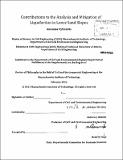| dc.contributor.advisor | Andrew J. Whittle. | en_US |
| dc.contributor.author | Vytiniotis, Antonios | en_US |
| dc.contributor.other | Massachusetts Institute of Technology. Dept. of Civil and Environmental Engineering. | en_US |
| dc.date.accessioned | 2012-05-15T21:10:19Z | |
| dc.date.available | 2012-05-15T21:10:19Z | |
| dc.date.copyright | 2011 | en_US |
| dc.date.issued | 2012 | en_US |
| dc.identifier.uri | http://hdl.handle.net/1721.1/70761 | |
| dc.description | Thesis (Ph. D.)--Massachusetts Institute of Technology, Dept. of Civil and Environmental Engineering, February 2012. | en_US |
| dc.description | Cataloged from PDF version of thesis. | en_US |
| dc.description | Includes bibliographical references (p. 319-328). | en_US |
| dc.description.abstract | This research analyzes the vulnerability of loose granular waterfront fills to liquefaction in seismic events and considers the effectiveness of Pre-fabricated Vertical (PV) drain systems in mitigating potential damage. The analyses are based on non-linear finite element simulations of coupled flow and deformation using the OpenSees open-source software framework. The analyses make extensive use of an advanced elasto-plastic model developed by Dafalias and Manzari (2004; DM2004) for simulating the cyclic response of sand. The model formulation is based on theories of bounding surface plasticity and critical state soil mechanics. The thesis presents a series of algorithms needed to achieve robust integration of the DM2004 model in OpenSees, documents model calibration for two test sands (Nevada, Toyoura), and evaluates its predictive capabilities and limitations at the element level. The results show that although the DM2004 model describes quite realistically the accumulation of plastic shear strains in drained and undrained cyclic shearing, the material can shakedown to a stable condition over a large number of load cycles (a condition of alternating plasticity). One-dimensional drain elements have been developed to represent laminar or turbulent discharge through the PV drains based on classic Darcy-Weisbach pipe flow. The elements also allow for fluid storage for cases where the PV drains extend through low permeability clay soils above the water table. The numerical predictions of ground response have been evaluated using results from a well-instrumented centrifuge model test (SSK01) performed by colleagues at the University of California at Davis (Kamai et al., 2008). The model includes a full array of PV drains installed within one of two facing slopes (directed towards a central channel) under a series of harmonically-varying horizontal base acceleration events. The simulations show reasonable predictions of accelerations, pore pressure accumulation and displacements within the untreated loose Nevada sand fill and the effectiveness of the PV drains in reducing permanent deformations within the slope. Numerical simulations of vulnerable piled-wharf structures have been carried out for the reference geometry of an 18m high, partially submerged fill slope (typical of port facilities on the USA West coast). This thesis describes the free-field simulations of ground response for a suite of 58 reference seismic ground motions from the NGA database (Chiou et al., 2008) and from Shakeout simulations (Graves et al., 2008) while a parallel study at the Georgia Institute of Technology (Shafieezadeh, PhD 2011) couples the predicted free-field pore pressures and ground deformations to the response of the piled-wharf structure. The numerical framework for free-field analyses involves special considerations of the boundary conditions to minimize the reflection of energy from far-field lateral boundaries and to represent mechanical and hydraulic interactions at the ocean-soil interface. The analyses use the DM2004 model with input parameters corresponding to Toyoura sand, and include parametric studies to evaluate how the in-situ fill density and hydraulic conductivity affect the ground response for a reference strong motion acceleration record. Numerical simulations have been performed for the suite of 58 reference ground motions for both the untreated (i.e., existing) fill and for the case where full-depth PV drains are installed at locations behind the crest of the slope (i.e., minimally-intrusive mitigation system). The computed permanent slope deformations are not well described by published empirical correlations, but are well correlated with the peak ground accelerations (PGA) and especially the Arias intensity (Ia), while directionality of the ground motions has minimal effects on the ground response. More detailed observations show that average shear strains (i.e., slope damage) are closely linked to the development of excess pore pressures within the slope. The PV drain mitigation system is effective in reducing permanent deformations and achieves an improvement ratio in the range 1.5-3.0 (untreated: PV deformations) that is insensitive to the ground motion characteristics. The damage results have been incorporated in slope fragility curves that can be used by risk analysts to quantify the expected costs from earthquake damage. | en_US |
| dc.description.statementofresponsibility | by Antonios Vytiniotis. | en_US |
| dc.format.extent | 419 p. | en_US |
| dc.language.iso | eng | en_US |
| dc.publisher | Massachusetts Institute of Technology | en_US |
| dc.rights | M.I.T. theses are protected by
copyright. They may be viewed from this source for any purpose, but
reproduction or distribution in any format is prohibited without written
permission. See provided URL for inquiries about permission. | en_US |
| dc.rights.uri | http://dspace.mit.edu/handle/1721.1/7582 | en_US |
| dc.subject | Civil and Environmental Engineering. | en_US |
| dc.title | Contributions to the analysis and mitigation of liquefaction in loose sand slopes | en_US |
| dc.type | Thesis | en_US |
| dc.description.degree | Ph.D. | en_US |
| dc.contributor.department | Massachusetts Institute of Technology. Department of Civil and Environmental Engineering | |
| dc.identifier.oclc | 788623037 | en_US |
